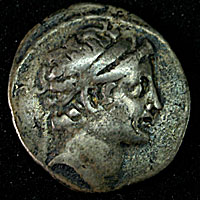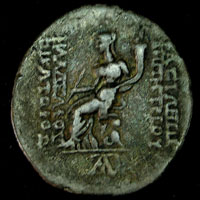weight: 14.9g; width: 2.66cm; die axis: 1h


OBV.: In fillet border, diademed head of Demetrios II right.
REV.: Tyche seated on backless throne, cradling a cornucopia in her left arm, holding a scepter in her right hand. The right leg of the throne has the form of a winged Tritoness (snake-bodied nymph). On right side of throne is inscribed "BASILEWS DHMHTRIOY" (= Basileos Demetriou, "of king Demetrios", on the left side "FILADELFOY NIKATOPOS" (= Philadelphou Nikatoros, "friend of his sibling, victor." AYT monogram in exergue.
HFMA nr. 2006.010.021. Ref.: SNG Spaer 1752; Houghton, CSE 1010 = SNG Lockett 3151, LeRider Suse, pl. XXIX.
By the time of Demetrios II Nikator, the once vast Seleucid Empire consisted of little more than Syria (encompassing today's Syria, Lebanon, northern Israel, and a small stretch of the southern coast of Turkey). Yet even this reduced realm was heavily contested.
In order to succeed his father on the throne, Demetrios first had to remove the usurper, Alexander I Balas, who had defeated and killed his father, Demetrios I Soter (162-150 BCE). Demetrios II succeeded in 145 BCE after Ptolemy VI of Egypt changed alliances and gave his daughter, Cleopatra Thea, who had been married to Alexander Balas, instead to Demetrios.
Another usurper arose at once: one of Alexander's officers, Diodotos Tryphon, first installed Alexander's young son as king Antiochus VI, then killed the child and declared himself king. Unable to gain the upper hand, Demetrios decided to embark on a new enterprise, a campaign against the Parthians under Mithradates I who had invaded Seleucid Mesopotamia. Yet in 138, the Parthians captured him. After nine years, when his younger brother, Antiochos VII, who had succeeded Demetrius as king and defeated Tryphon, marched into Parthia, the Parthians released Demetrios to cause problems for Antiochos. Instead, Antiochos died in battle, and Demetrios could resume his rule for another three years (129-126 BCE). He now attempted to conquer Egypt, but failed, and was finally murdered in Tyre.
The head of Demetrios on the coins from his first reign (145-138 BCE) reflects the fact that he was only between 14 and 16 years of age when he ascended to the throne. The reverse touts him, inter alia, as Nikator ("victor"), to promote his victory over the usurper Alexander Balas. The goddess Tyche, the guarantor of fortune and prosperity, appears frequently on Seleucid coins; the founder of the dynasty, Seleucus I Nikator (king from 305-281 BCE), had erected a temple to Tyche in his capital, Antioch-on-the-Orontes, that displayed a famous bronze statue of the goddess by the sculptor Eutychides (a smaller marble copy is now in the Vatican Museum).
This particular coin, minted in the administrative center for Seleucid Mesopotamia, Seleucia-on-the-Tigris, must have been produced before July 141 BCE, when the Parthians conquered this city and nearby Babylon (1).
O.K.
(1) For the date, see Hoover, Antiochos VII.
Literature:
Grainger, John D. A Seleukid Prosopography and Gazetteer. Leiden: Brill, 1997.
Hoover, Oliver D. Seleucid Genealogies and Biographies.

